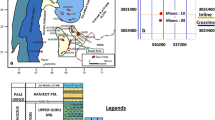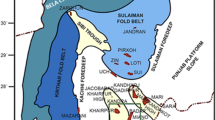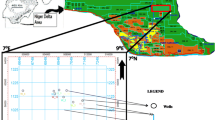Abstract
Incised valleys form excellent stratigraphic pinch-out traps. Traditional seismic data analysis techniques fail to predict quantitatively the porous and low-velocity sand-fills for incised valleys. The 3D quantitative seismic inverted porosity–velocity (3DQSIPV) analysis was applied in the Indus Basin, SW Pakistan. The reflection strength attribute better portrayed the reservoir sandstone and faults compared to seismic amplitude attribute. The sweetness-based continuous wavelet transform authenticated the development of the stratigraphic play. The 17 Hz amplitude delineated the non-porous seal and porous reservoirs of sand-filled incised valley and strand plain, and faults. The integrated model of seismic attributes categorizes the reservoir and seal constituents. The petrophysical modeling corroborated the gas-bearing “sweet-spots” within the stratigraphic-based dynamical system. The facies modeling predicted the for coarse-grained sandstone and fine-grained shales, depositional environments, fluctuations of sea level and their impacts on the overall development of stratigraphic plays. The predicted density and P-wave velocity for the sandstone-filled incised valley of the lowstand system tract were ~ 1.4–1.75 g/cc and ~ 3217–3802 m/s, respectively. The predicted density and P-wave velocity for the sealing shales facies of strand plain of transgressive system tract were ~ 1.9–2.1 g/cc and 2.55–2.7 g/cc and 3900–4700 m/s, respectively. The 3DQSIPV predicted > 25% porosity and ~ 3300 m/s velocity of reservoirs in the west. The eastern zones shows < 12% porosity and high velocity of ~ 4580 m/s. Cross-plots of porosity, velocity, and thickness showed correlation coefficients of R2 > 0.90 for inverted velocity. This workflow may serve as an analogue for the remaining oil and gas fields of the Indus Basins of Pakistan and similar geological settings of divergent plate margins.
















Similar content being viewed by others
References
Abushalah, Y., & Serpa, L. (2018). Application of amplitude spectrum and genetic inversion to determine shaly facies distribution: A case study: Murzuq basin, Libya. Geophysical Prospecting, 66(6), 1144–1158.
Ahmed, N., Fink, P., Sturrock, S., Mahmood, T., & Ibrahim, M. (2004). Sequence stratigraphy as predictive tool in Lower Goru fairway, Lower and Middle Indus Platform, Pakistan. In: Pakistan Association of Petroleum Geoscientists, Annual Technical Conferance (pp. 85–104).
Ahmed, W., Azeem, A., Abid, M. F., Rasheed, A., & Aziz, K. (2013). Mesozoic structural architecture of the Middle Indus Basin, Pakistan—controls and implications. Pakistan Association of Petroleum Geoscientists/Society of Petroleum Engineering. Annual Technical Conference, Islamabad, Pakistan, 1–13.
Alamsyah, M. N., Marmosuwito, S., Sutjiningsih, W., Marpaung, L. P., & Sukmono, S. (2008). Seismic reservoir characterization of Indonesia’s Southwest Betara Field. The Leading Edge, 27(12), 1598–1607.
Andreassen, K., Nilssen, E. G., & Ødegaard, C. M. (2007). Analysis of shallow gas and fluid migration within the Plio-Pleistocene sedimentary succession of the SW Barents Sea continental margin using 3D seismic data. Geo-Marine Letters, 27(2–4), 155–171.
Barnes, A. E. (1991). Instantaneous frequency and amplitude at the envelope peak of a constant-phase wavelet. Geophysics, 56, 1058–1060.
Barnes, A. E. (1992). Instantaneous spectral bandwidth and dominant frequency with applications to seismic reflection data. Geophysics, 58(3), 419–428.
Bellwald, B., Planke, S., Piasecka, E. D., Matar, M. A., & Andreassen, K. (2018). Ice-stream dynamics of the SW Barents Sea revealed by high-resolution 3D seismic imaging of glacial deposits in the Hoop area. Marine Geology, 402, 165–183.
Bowen, D. W., & Weimer, P. (2003). Regional sequence stratigraphic setting and reservoir geology of Morrow incised-valley sandstones (lower Pennsylvanian), eastern Colorado and western Kansas. American Association of Petroleum Geologists Bulletin, 87(5), 781–815.
Chen, Q., & Sidney, S. (1997). Seismic attribute technology for reservoir forecasting and monitoring. The Leading Edge, 16(5), 445–448.
Chopra, S., & Alexeev, V. (2006). Applications of texture attribute analysis to 3D seismic data. The Leading Edge, 25(8), 934–940.
Chopra, S., & Marfurt, K. J. (2005). Seismic attributes-A historical perspective. Geophysics, 70(5), 3–28.
Cohen, L. (1995). Time-Frequency Analysis, Prentice-Hall Signal Processing Series.
Eng, C., & Tsuji, T. (2019). Influence of faults and slumping on hydrocarbon migration inferred from 3D seismic attributes: Sanriku-Oki forearc basin, northeast Japan. Marine and Petroleum Geology, 99, 175–189.
Fitzgerald, D. M., Cleary, W. J., Buynevich, I. V., Hein, C. J., Klein, A., Asp, N., & Angulo, R. (2007). Strandplain evolution along the southern coast of Santa Catarina, Brazil. Journal of Coastal Research, 50, 152–156.
Gray, F. D., Anderson, P. F., & Gunderson, J. A. (2006). Prediction of shale plugs between wells in heavy oil sands using seismic attributes. Natural Resources Research, 15(2), 103–109.
Isiaka, A. I., Durrheim, R. J., Manzi, M. S., & Andreoli, M. A. (2017). 3D seismic analysis of the AK Fault, Orange Basin, South Africa: Implications for hydrocarbon leakage and offshore neotectonics. Tectonophysics, 721, 477–490.
Kumar, P. C., & Sain, K. (2018). Attribute amalgamation-aiding interpretation of faults from seismic data: An example from Waitara 3D prospect in Taranaki basin off New Zealand. Journal of Applied Geophysics, 159, 52–68.
Landrø, M. (2011). Petroleum geoscience: From sedimentary environments to rock physics (pp. p360-373). Springer.
Li, Y., Zheng, X., & Zhang, Y. (2011). High-frequency anomalies in carbonate reservoir characterization using spectral decomposition. Geophysics, 76(3), V47–V57.
McCubbin, D. G. (1982). Barrier-island and strand-plain facies. In P. A. Scholle & D. Spearing (Eds.), Sandstone Depositional Environments: Memoir no. 31, Tulsa, Oklahoma (pp. 247–279). American Association of Petroleum Geologists.
Naseer, M. T. (2020). Seismic attributes and reservoir simulation application to image the shallow-marine reservoirs of middle-Eocene carbonates, SW Pakistan. Journal of Petroleum Science and Engineering, 195, 107711.
Naseer, M. T., & Asim, S. (2017a). Continuous wavelet transforms of spectral decomposition analyses for fluvial reservoir characterization of Miano Gas Field, Indus Platform, Pakistan. Arabian Journal of GeoSciences, 10(9), 210.
Naseer, M. T., & Asim, S. (2017b). Detection of cretaceous incised-valley shale for resource play, Miano gas field, SW Pakistan: Spectral decomposition using continuous wavelet transform. Journal of Asian Earth Sciences, 147, 358–377.
Naseer, M. T., & Asim, S. (2018a). Application of instantaneous spectral analysis and acoustic impedance wedge modeling for imaging the thin beds and fluids of fluvial sand systems of Indus Basin, Pakistan. Journal of Earth System Science, 127, 97. https://doi.org/10.1007/s12040-018-0997-1
Naseer, M. T., & Asim, S. (2018b). Porosity prediction of lower cretaceous unconventional resource play, south Indus Basin, Pakistan, the using seismic spectral decomposition technique. Arabian Journal of GeoSciences, 11, 225. https://doi.org/10.1007/s12517-018-3566-7
Naseer, M. T., & Asim, S. (2018c). Characterization of shallow-marine reservoirs of Lower Eocene carbonates, Pakistan: Continuous wavelet transforms-based spectral decomposition. Journal of Natural Gas Science and Engineering, 56, 629–649.
Naseer, T. M., Asim, S., Ahmad, M. N., Hussain, F., & Qureshi, S. N. (2014). Application of seismic attributes for delineation of channel geometries and analysis of various aspects in terms of lithological and structural perspectives of Lower Goru Formation, Pakistan. International Journal of Geosciences, 5(12), 1490.
Neto, A. A., Mota, B. B., Belem, A. L., Albuquerque, A. L., & Capilla, R. (2016). Seismic peak amplitude as a predictor of TOC content in shallow marine sediments. Geo-Marine Letters, 36(5), 395–403.
Oyeyemi, K. D., Olowokere, M. T., & Aizebeokhai, A. P. (2018). Prospect analysis and hydrocarbon reservoir volume estimation in an exploration field, shallow offshore depobelt, western niger Delta, Nigeria. Natural Resources Research, 28, 173–185.
Phoosongsee, J., Morley, C. K., & Ferguson, A. J. (2019). Quantitative interpretation of seismic attributes for reservoir characterization of Early-Middle Miocene syn-and post-rift successions (Songkhla Basin, Gulf of Thailand). Marine and Petroleum Geology, 109, 791–807.
Posamentier, H. W., & Allen, G. P. (1999). Siliciclastic sequence stratigraphy: concepts and application. SEPM Concepts in Sedimentology and Paleontology, 7, 210.
Radovich, B. J., & Oliveros, R. B. (1998). 3D sequence interpretation of seismic instantaneous attributes from the gorgon field. The Leading Edge, 17(9), 1286–1293.
Raeesi, M., Moradzadeh, A., Doulati, A. F., & Rahimi, M. (2012). Classification and identification of hydrocarbon reservoir lithofacies and their heterogeneity using seismic attributes, logs data and artificial neural networks. Journal of Petroleum Science and Engineering, 82, 151–165.
Raef, A. E., Mattern, F., Phillip, C., & Totten, M. W. (2015). 3D seismic attributes and well-log facies analysis for prospect identification and evaluation: Interpreted palaeoshoreline implications, Weirman Field, Kansas, USA. Journal of Petroleum Science and Engineering, 133, 40–51.
Roden, R., Smith, T., & Sacrey, D. (2015). Geologic pattern recognition from seismic attributes: Principal component analysis and self-organizing maps. Interpretation, 3(4), 59–83.
Ryer, T. A., Gustason, E. R., & Odland, S. K. (1986). Stratigraphy, sea level fluctuations, and depositional history of Lower Cretaceous Muddy Sandstone, northern Powder River basin, Wyoming; American Association of Petroleum Geologists Bulletin (United States), 70 (CONF-8609129).
Sadikh-Zadeh, L. A. (2006). Prediction of sandstone porosity through quantitative estimation of its mechanical compaction during lithogenesis (Bibieybat Field, South Caspian Basin). Natural Resources Research, 15(1), 27–32.
Sinha, S., Routh, P. S., Anno, P. D., & Castagna, J. P. (2005). Spectral decomposition of seismic data with continuous-wavelet transform. Geophysics, 70(6), 19–25.
Stright, L., Bernhardt, A., Boucher, A., Mukerji, T., & Derksen, R. (2009). Revisiting the use of seismic attributes as soft data for sub seismic facies prediction: Proportions versus probabilities. The Leading Edge, 28(12), 1460–1468.
Sullivan, E. C., Marfurt, K. J., Lacazette, A., & Ammerman, M. (2006). Application of new seismic attributes to collapse chimneys in the Fort Worth Basin. Geophysics, 71(4), 111–119.
Taner, M. T. (2001). Seismic attributes. Canadian Society of Exploration Geophysics Recorder, 26(7), 48–56.
Tayyab, M. N., & Asim, S. (2017). Application of spectral decomposition for the detection of fluvial sand reservoirs, Indus Basin, SW Pakistan. Geosciences Journal, 1–11.
Tayyab, M. N., Asim, S., Siddiqui, M. M., Naeem, M., Solange, S. H., & Babar, F. K. (2017). Seismic attributes’ application to evaluate the Goru clastics of Indus Basin, Pakistan. Arabian Journal of Geosciences, 10(7), 158.
Van, H. T., Gesbert, S., & Pickens, J. (2010). Geometric attributes for seismic stratigraphic interpretation. The Leading Edge, 29(9), 1056–1065.
von Hartmann, H., Buness, H., Krawczyk, C. M., & Schulz, R. (2012). 3D seismic analysis of a carbonate platform in the Molasse Basin-reef distribution and internal separation with seismic attributes. Tectonophysics, 572, 16–25.
Wu, S., Yuan, S., Zhang, G., Ma, Y., Mi, L., & Xu, N. (2009). Seismic characteristics of a reef carbonate reservoir and implications for hydrocarbon exploration in deepwater of the Qiongdongnan Basin, northern South China Sea. Marine and Petroleum Geology, 26(6), 817–823.
Zeng, H., Loucks, R. G., & Brown, L. F., Jr. (2007). Mapping sediment-dispersal patterns and associated systems tracts in fourth-and fifth-order sequences using seismic sedimentology: Example from Corpus Christi Bay, Texas. American Association of Petroleum Geologist Bulletin, 91(7), 981–1003.
Zeng, H., Loucks, R., Janson, X., Wang, G., Xia, Y., Yuan, B., & Xu, L. (2011). Three-dimensional seismic geomorphology and analysis of the Ordovician paleokarst drainage system in the central Tabei Uplift, northern Tarim Basin, western China. American Association of Petroleum Geologist Bulletin, 95(12), 2061–2083.
Acknowledgments
Dr Muhammad Tayyab Naseer is thankful to the Directorate General of Petroleum Concession (DGPC) for permission to publish this paper. I am also thankful to the Department of Earth Sciences, Quaid-I-Azam University and LMKR for providing the research data. I am grateful to the respected reviewers for their positive criticism, which made our manuscript in an excellent form and acceptable. The author is highly thankful for seismic microtechnology (SMT)-Kingdom Software 8.6 Support, for providing the academic license of the geological and geophysical boards, and their excellent support during this research work.
Author information
Authors and Affiliations
Corresponding author
Appendix
Appendix
Strand Plain
A strand plain or strand plain is a broad belt of sand along a shoreline with a surface exhibiting well-defined parallel or semi-parallel sand ridges separated by shallow swales. A strand plain differs from a barrier island in that it lacks either the lagoons or tidal marshes that separate a barrier island from the shoreline to which the strand plain is directly attached. In addition, the tidal channels and inlets that cut through barrier islands are absent. Strand plains typically are created by the redistribution by waves and longshore currents of coarse sediment on either side of a river mouth. Thus, they are part of one type of wave-dominated delta (Fitzgerald et al., 2007; McCubbin, 1982).
Incised-valley
An incised valley forms when a river has cut into its floodplain or underlying strata sufficiently that even at the flood stage, the flow does not overtop the banks. The formerly active floodplain is left abandoned to serve as interfluves (Posamentier, 1999). Valley incision can occur as a result of base-level fall, tectonic tilting of an alluvial plain, and/or decrease in fluvial discharge to form underfit streams. During the stage in which valley incision of the underlying substrate occurs, fluvial sediment is transported downstream, beyond the confines of the valley. Filling occurs mainly during the turnaround and rise of the base level. The fill of a valley can be quite complex, both laterally and vertically. Laterally, the same meandering-river processes that were described earlier in this chapter occur in incised valleys, so the resulting deposits are equally complex. The horizontal transect of a valley fill also varies in the downstream direction, with primarily fluvial deposits upstream and more marine-influenced deposits downstream (Bowen & Weimer, 2003). Vertically, the ideal valley-fill sequence consists of a basal fluvial lag, which grades upward into fluvial sandstones, and these are overlain by estuarine sandstones and mudstones and then shelf mudstones. However, the vertical sequence will exhibit a preponderance of fluvial strata upstream and more estuarine strata downstream, closer to the marine environment.
Rights and permissions
About this article
Cite this article
Naseer, M.T. Imaging of Stratigraphic Pinch-Out Traps Within the Lower-Cretaceous Shaly-Sandstone System, Pakistan, Using 3D Quantitative Seismic Inverted Porosity–Velocity Modeling. Nat Resour Res 30, 4297–4327 (2021). https://doi.org/10.1007/s11053-021-09932-3
Received:
Accepted:
Published:
Issue Date:
DOI: https://doi.org/10.1007/s11053-021-09932-3




